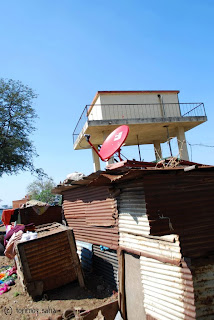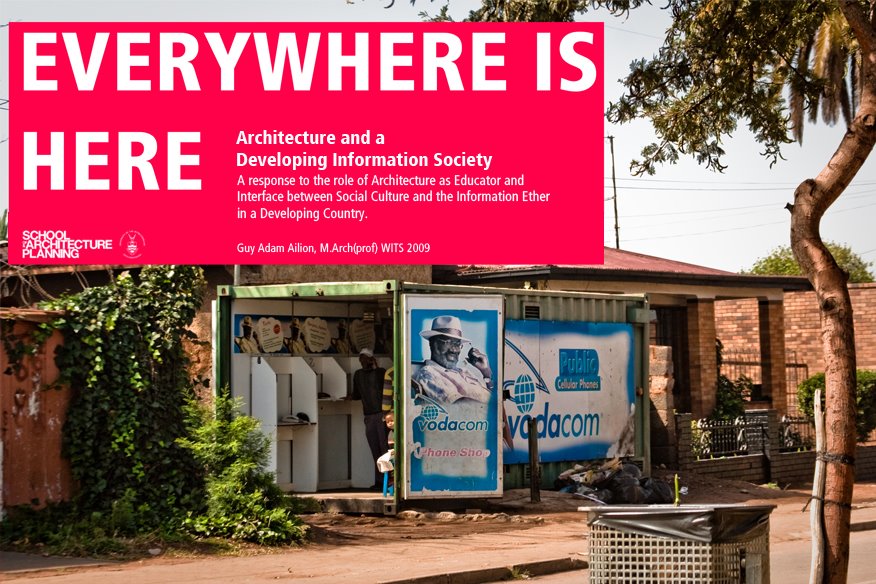I thought this would make a good starting point for the blog, here are two video's promoting the incredible concept and initiative of Nicholas Negroponte's 'One Laptop Per Child' (OLPC) initiative aimed at providing less privileged communities and their children access to the world's knowledge and immense opportunities for education.
Here is the Official Site: http://www.laptop.org/en/
One Laptop per Child : Zimi's Story FULL
OLPC Mission
Sunday, March 22, 2009
First Writings

In a developing city, access to the world's knowledge through the internet could stimulate innovation, entrepreneurship, new models of individual and community learning and perpetuate economic growth.
While, politics, economics, and infrastructure are key role players in developing systems for the correct use of Information Technologies and all communications in a city, Architecture or space-making has a role and opportunity in the communication of these developments to the public realm and could provide an extended platform of interaction, participation, transparency and communication that may propagate the creation of an urban culture of knowledge and innovation.
The purpose of the thesis is to explore the tremendous opportunities for innovation and advancement that the technologies of the information revolution might offer to the future of architecture and space making in an intelligent city. Where architecture recognises the need for a culture of technology in what is increasingly being called the Knowledge Society. The nurturing of a culture of knowledge/technology may act as a catalyst for economic advancement, public interest and innovation and new increased socio-spatial communication in an urban context.
By outlining the cultural, spatial and institutional constraints presented by a developing country’s existing systems and mentalities, I hope to identify what manoeuvrability there is for innovation in the creation of architectural space that best represents and explores the age of Technology and Information and notably in the context of an African developing city.
The Information Revolution and the implementation of its technologies into cities and societies is treated only as a economic and infrastructural exercise that assumes that this invisible technology will be understood and accepted at full potential by the public (end-user). Two problems surface at first glance: the first being the absence of the ‘real’ in observing and dissemination of the ‘virtual’ technology. What I mean here is that most new information technologies and their associated data are invisible. This Information ether only manifests itself through media interfaces and screens. There is need to represent these specific technologies physically and spatially where participation is on a more physically tectonic, interactive, and observable level. The second and most topical in this thesis is that of our social culture toward information and technology.
The term Culture of Technology is used here to characterize the nature of the challenges faced by developing countries and an increasing age of fast-changing technology. It also suggests a higher level of difficulty compared to just the transfer of technological hardware. The latter is mechanized and pre-determined while the former is organic and open-ended and may require a deeper level of unconscious and conscious engagement. Space-making or Architecture could be seen as the vital large scale physical manifestation that can curb the 2 problems outlined above. Where “Architecture is the built form of our cultural ambitions” (Reed Kroloff) it has the ability to tell stories, express messages, be playful, educate, and be communicative and socially interactive thus stimulating the public participator or even passer-by into the creation of a particular culture of use. Architecture sees the point of contact with the public in an urban environment and it is at this point that Information Technology could be innovative and apply more ‘real’ human activity.
Saturday, March 21, 2009
Welcome Note
Hi Everyone, or no-one.
Welcome to my digital thoughts and ramblings.
This Blog will document and map my viral research and findings as I process, respond, and compile my thesis. The intent of this blog is to both share my information and research process with the online community, as well as provide a platform to receive input from anyone and no-one. I will post whatever I find along the way that is interesting, whether it will feature in my thesis or not. Because this is a Viral blog (containing internet data) it will comprise of mainly Video Content, Links to Articles, Images, and my thoughts.
Feel free to comment or observe in silence. I will update as much as I can along the way if the sh*t doesn't hit the fan to early.
let's begin.
Welcome to my digital thoughts and ramblings.
This Blog will document and map my viral research and findings as I process, respond, and compile my thesis. The intent of this blog is to both share my information and research process with the online community, as well as provide a platform to receive input from anyone and no-one. I will post whatever I find along the way that is interesting, whether it will feature in my thesis or not. Because this is a Viral blog (containing internet data) it will comprise of mainly Video Content, Links to Articles, Images, and my thoughts.
Feel free to comment or observe in silence. I will update as much as I can along the way if the sh*t doesn't hit the fan to early.
let's begin.
Subscribe to:
Posts (Atom)
